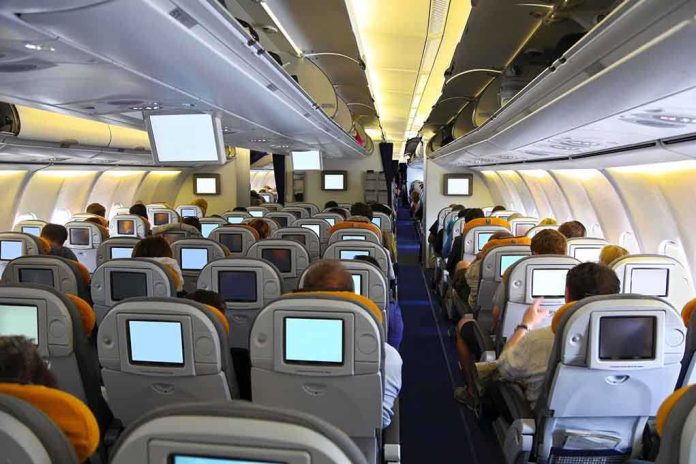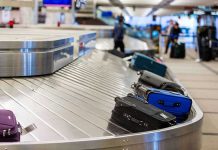
One overlooked item in an airplane seatback pocket—a used hypodermic needle—has triggered a $5 million lawsuit that may change how airlines are held accountable for passenger safety and emotional trauma.
Story Snapshot
- A Virginia military veteran is suing EgyptAir for $5 million after being pricked by a used needle during a flight from Cairo to Washington, D.C.
- The incident led to months of medical treatment and psychological distress for the passenger, who feared exposure to HIV and hepatitis.
- The lawsuit alleges EgyptAir failed to respond to inquiries or provide information needed for post-exposure care, highlighting gaps in airline protocol.
- The case raises broader questions about airline liability, passenger rights, and the responsibility to prevent hazardous exposures in flight cabins.
Cabin Safety on Trial: The Needle in the Seatback
John Doe, an American military veteran, boarded EgyptAir flight MS981 on October 16, 2024, expecting a routine trip from Cairo to Washington, D.C. Instead, he reached into the seatback pocket and was punctured by a used hypodermic needle—a mundane gesture with life-altering consequences. His shock was immediate, but what followed over the next months was a relentless ordeal of medical tests, post-exposure treatments, and the ever-present fear of contracting serious diseases like HIV and hepatitis. The object, small and easily overlooked, became a symbol of a much bigger issue: just how safe are the spaces we trust when we travel?
The lawsuit, filed in Alexandria, Virginia’s federal court in late 2025, seeks $5 million in damages from EgyptAir. Doe’s attorney, Abram Bohrer, contends that EgyptAir not only failed to maintain a safe environment but also compounded the trauma by ignoring Doe’s requests for vital information. Without answers about the needle’s origin, Doe endured months of grueling post-exposure therapy—an experience marked by uncertainty and anxiety that no amount of pre-flight safety demonstrations could prepare a passenger for.
Legal Precedents and the Montreal Convention
The incident is not without precedent. Airlines have faced similar lawsuits before—a Michigan woman sued Etihad Airways after a needle stick injury, and the courts have debated the extent of airline liability. The Montreal Convention, which governs international air carriage, establishes that airlines are liable for passenger injuries during flights, but the legal terrain becomes murkier when it comes to emotional distress. Some courts have ruled that if emotional harm arises directly from a physical injury, damages may be awarded. This evolving legal standard has placed airlines under increasing scrutiny, especially as more passengers have reported hazardous materials left in cabins.
Airlines are required to clean cabins between flights, but the reality often falls short of the standard. The seatback pocket, a catch-all for magazines, wrappers, and now, apparently, medical waste, has become a focal point for concerns about passenger safety. The needle in Doe’s case was not just a personal hazard—it was a warning signal for systemic issues in airline protocols and the adequacy of cleaning practices, especially in an era of heightened health awareness post-pandemic.
Passenger Rights, Airline Responsibilities, and Psychological Fallout
Doe’s experience underscores the psychological toll that such incidents can exact. For months, he lived with the specter of infectious disease, enduring both medical procedures and the emotional burden of uncertainty. His attorney accuses EgyptAir of “dehumanizing” its passengers by failing to respond—a charge that, if proven, could add significant weight to the compensation claim and set a new benchmark for airline accountability. The lack of a public statement from EgyptAir only fuels speculation about industry-wide neglect and the adequacy of existing regulations.
This lawsuit arrives at a moment when airlines are already under the microscope for their pandemic-era hygiene practices. Passengers, once focused on legroom and meal service, now weigh the risk of invisible dangers. For EgyptAir, the immediate concern is financial and reputational; for the broader industry, the stakes are regulatory and existential. If Doe prevails, airlines may need to overhaul cleaning protocols, improve transparency, and provide more robust post-incident support, fundamentally recalibrating what it means to protect passengers.
The Stakes for Future Travel: What’s Next?
The outcome of Doe’s lawsuit could ripple far beyond a single passenger’s fate. A significant judgment in his favor might embolden others to seek redress for emotional as well as physical harm, pressuring airlines to adopt stricter cleaning and reporting standards. Legal experts are divided—some argue that expanding liability for emotional distress could open the floodgates to costly litigation, while others maintain that passenger safety demands nothing less than full accountability for all harm suffered in flight.
For now, the story serves as both a cautionary tale and a call to action. It reminds travelers that even the smallest oversight—a forgotten needle in a pocket—can have outsized consequences. It also prompts airlines and regulators to confront uncomfortable questions about safety, transparency, and the true cost of a ticket. As the case unfolds in federal court, passengers and airlines alike will be watching, knowing that the next overlooked hazard could be waiting just a seatback away.













